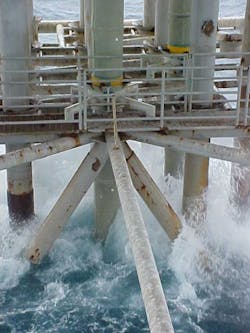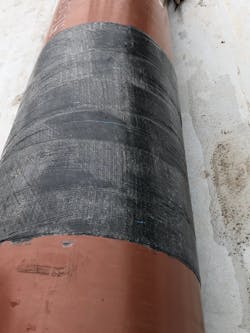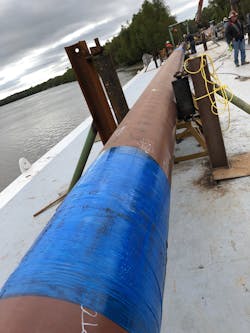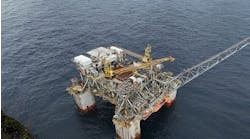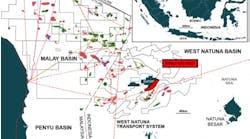Matt Green and Tammy Bomia, ClockSpring|NRI
Corrosion is costly, and offshore asset owners are paying a steep price. Finding reputable methods of mitigating costs without compromising safety is a challenge. Plus, it is particularly critical at a time when so many aging assets are remaining onsite for longer than initially planned.
According to numbers published by the World Corrosion Organization in 2019, the cost of corrosion in all industries worldwide is 3% to 4% of GDP in industrialized countries. A presentation made by Lasse Isaksen, Global Concept Director, Offshore, for Jotun at the 2019 INTSOK event in Houston includes even more sobering numbers. According to Isaksen, 5 metric tons (5.5 tons) of steel is degenerated every second, and 40% of all steel produced in the world is used to replace steel damaged by corrosion.
Defining the problem
The reason for these astronomical numbers is due in part to the ubiquitous use of steel in construction. A massive amount of steel goes into offshore assets from jackups and drillships to platforms and FPSOs. All this metal is subject to degradation, which explains why corrosion accounts for approximately 60% of offshore maintenance cost.
Steel corrodes over time as it reacts with the saltwater environment, both aqueous and atmospheric. Pitting, or localized corrosion, causes high-stress-intensity regions that can lead to structural strength degradation, fatigue cracks and buckling. On areas of the structure exposed to bending and loading, fatigue can lead to additional damage, significantly compromising structural integrity. More than 60% of leaks on hydrocarbon systems are caused by fatigue and corrosion.
Steps are taken in every construction program to mitigate corrosion. Among these are the use of physical barriers designed to protect metal from the effects of humidity and exposure to saltwater. Common methods include organic and metallic protective coatings, corrosion resistant alloys, plastics and polymers, corrosion inhibitors, and cathodic protection.
Identifying the challenges
Regardless of the protective measures taken, at some point, steel used offshore suffers from corrosion. In many cases, the steel is replaced. In others, it is repaired with steel plates or cleaned and re-covered with traditional protective materials.
When components corrode, there are unique considerations that need to be taken into account when determining how to restore integrity. For example, complex geometry poses specific challenges. Some traditional repair methods cannot contend with joints, welds, tees, and bends. When the corroded component is in a confined space or in an area where access is restricted, the number of viable solutions is limited.
Corrosion under insulation (CUI) is one of the most insidious problems for offshore assets. CUI is a severe form of localized external corrosion that affects steel that has been insulated. It occurs when water is absorbed by or collected in the insulation. Because the corrosion is not visible, it is difficult to detect both in terms of location and severity, which means extensive degradation can take place before the owner is aware of the damage. If undetected, the results of CUI can lead to the shutdown of a process unit or an entire facility, and in some cases, it can lead to an unplanned hydrocarbon release.
Some solutions, such as replacing a damaged component or welding steel on top of a degraded area, require skilled installers and a weather window that permits the work to proceed safely. And in most cases, repairs cannot take place with the system in service. On producing assets, this means production is shut in while repairs are made, which dramatically increases the cost. In fact, the traditional methods of carrying out maintenance offshore are 15-20 times more costly than work performed in a yard.
There is no way to entirely avoid corrosion, and compromising safety is not an option. So, if safety is to be restored affordably to offshore assets, alternative approaches to prevention and mitigation are needed.
Composite technology has been used for decades to safely protect or rehabilitate steel. It has proven to be robust and long-lasting in a range of applications. Composites are 10-30 times stronger than liquid epoxies and have approximately 10 times greater fracture toughness. With the broad range of engineered composite repair (ECR) systems available, there is a proven solution for nearly every type of corrosion found offshore.
Prevention
Preventing corrosion is much more effective than restoring damaged steel. One way to protect risers and pipelines is to cover it with a sacrificial composite layer. Scar-Guard was developed specifically to protect field joint and mainline coatings from the mechanical stresses and scarring associated with horizontal directional drilling, boring and micro-tunneling of pipelines. Used onshore to protect pipelines from gouging and scratching during installation, it has made its way into applications offshore.
This sacrificial outer laminate system protects pre-approved anti-corrosion coatings, such as fusion bonded epoxy, liquid epoxies, shrink sleeves, and tapes, providing robust protection of the underlying pipeline coating. It ensures pipeline integrity and prevents future external corrosion without introducing environmental hazards. Because this composite is delivered in rolls, it is easy to transport to the worksite and can be installed without special tools and equipment.
In a recent application, a boat transported personnel and the composite system to a barge where the installation team planned to apply the composite to a pipeline. Before the composite was used, a coating approved by the asset owner was applied to the line. Once the coating was set, technicians wrapped the pre-impregnated, tri-axial fiberglass laminate around the pipeline. Designed to set in approximately 30 minutes, the composite was applied quickly on the deck of the barge, allowing the pipeline to be installed without considerable delay. Because the sacrificial coating is highly resistant to degradation, it will enable a long service life by impeding corrosion.
This composite system was laboratory tested to determine its performance characteristics in comparison to two commercially available, liquid, field-applied epoxy field joint coatings (FJCs) that were not covered with the fiber reinforced polymer. In terms of material stiffness or resistance to deformation, the composite performed to 4 million psi while the epoxy was unable to sustain more than 250,000 psi. To test fracture toughness, the specimens were pre-cracked, then taken to failure using a tensile machine. The ability to resist fracture was calculated based on the results. In summary, this composite is approximately 10-30 times greater than the epoxy FJCs, exhibit stiffness 10-20 times greater, and fracture toughness about 10-15 times greater. The lower strength, stiffness, and fracture toughness led to the epoxy FJCs suffering from chipping, cracking, peeling, spalling, flaking, and blistering before the composite under similar loading.
An effective cure
More often than not, components are not protected with composite materials before installation, which means they eventually corrode. When corrosion takes place under insulation, it is not only difficult to identify, but also very challenging to correct using traditional repair methods. The need for a better solution led to the development of the Contour composite system, which has been used to address CUI damage on offshore assets around the world.
This ECR is an advanced fiberglass fabric applied with toughened epoxy resin. The fabric is combined with the resin on site, enabling the system to be tailored to fit most geometries, such as tees, elbows, and welded joints, at the time of installation without pre-cutting or off-site customization. A set of calculations completed using site specific data determines the thickness of the repair required, meaning that in principle, each repair is bespoke. The composite is applied in accordance with the requirements of ISO TS 24817 or ASME PCC-2 Article 4.1, and as such, it is classed as an engineered repair.
Applied on site by trained technicians, the fabric is wetted with resin, then applied to the pipe. The resin bonds the fabric in place, seals leaks, provides chemical resistance, and prevents further external corrosion. A disposable peel ply layer is applied at the end of each repair to protect the applied material. When the peel ply is removed, more layers can be added, or if the ECR is completely installed, can be coated or painted.
This ECR was used recently on a platform in the Gulf of Mexico to repair a 16-in. CUI-damaged seawater line that had suffered through-wall loss and additional surrounding internal corrosion. The owner wanted a quick installation that would deliver a short-term solution to extend the service life of the line, allowing it to remain online for as long as possible. The ECR was designed to PCC-2 standards and delivered to the site for installation.
All repairs on offshore assets are carried out according to ISO 24817 2015 guidelines. These provide requirements and recommendations for qualifying, designing, installing, testing, and inspecting the external application of composite repair systems to corroded or damaged pipework, pipelines, tanks, and vessels used in the petroleum and natural gas industries. For this application six layers of the wet-lay composite system were applied using the standard installation procedures over an axial length of 4.5 ft (1.4 m). The work was completed in less than a day, despite limited clearance for the repair and the need to use rope access. The ECR restored the line to safe service, guaranteeing that it would perform to specifications for the two years or required service before the next scheduled outage, during which the owner would decide if the damaged line should be replaced.
Contending with corrosion
Tested, validated, and field proven composite solutions have been applied globally in pipelay operations to prevent corrosion damage and to address potentially catastrophic consequences of CUI. These and many other composite solutions are readily available, and continuing R&D efforts are creating even more advanced products. Mitigating corrosion through ECRs is a long-term solution that enables statutory and corporate compliance with HSE requirements, reduces unplanned maintenance, and decreases production losses. Composite solutions continue to gain acceptance, but they are not used nearly as widely as they should be if the industry wants to improve the economics of corrosion management. •
